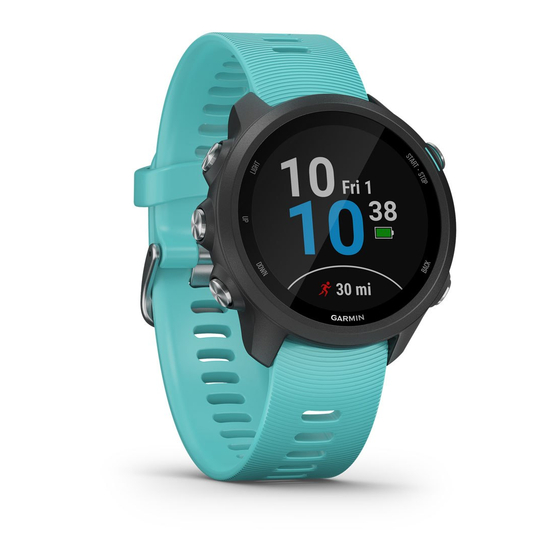Garmin FORERUNNER 245 Kullanıcı El Kitabı - Sayfa 35
İzle Garmin FORERUNNER 245 için çevrimiçi göz atın veya pdf Kullanıcı El Kitabı indirin. Garmin FORERUNNER 245 40 sayfaları.

Last Length Stroke Rate: The average number strokes per
minute (spm) during the last completed pool length.
Last Length Strokes: The total number of strokes for the last
completed pool length.
Last Length Stroke Type: The stroke type used during the last
completed pool length.
Last Length Swolf: The swolf score for the last completed pool
length.
Lat/Lon: The current position in latitude and longitude
regardless of the selected position format setting.
Lengths: The number of pool lengths completed during the
current activity.
Location: The current position using the selected position
format setting.
Maximum Speed: The top speed for the current activity.
Next Waypoint: The next point on the route. You must be
navigating for this data to appear.
Off Course: The distance to the left or right by which you have
strayed from the original path of travel. You must be
navigating for this data to appear.
Pace: The current pace.
Performance Condition: The performance condition score is a
real-time assessment of your ability to perform.
Repeat On: The timer for the last interval plus the current rest
(pool swimming).
Reps: During a strength training activity, the number of
repetitions in a workout set.
Rest Timer: The timer for the current rest (pool swimming).
Set Timer: During a strength training activity, the amount of time
spent in the current workout set.
Speed: The current rate of travel.
Stride Length: The length of your stride from one footfall to the
next, measured in meters.
Stroke Rate: Swimming. The number of strokes per minute
(spm).
Stroke Rate: Paddle sports. The number of strokes per minute
(spm).
Strokes: Paddle sports. The total number of strokes for the
current activity.
Sunrise: The time of sunrise based on your GPS position.
Sunset: The time of sunset based on your GPS position.
Temperature: The temperature of the air. Your body
temperature affects the temperature sensor.
VO2 Max. Standard Ratings
These tables include standardized classifications for VO2 max. estimates by age and gender.
Males
Percentile
95
80
60
40
0-40
Females
Percentile
Superior
95
Excellent
80
Good
60
Fair
40
0-40
Data reprinted with permission from The Cooper Institute. For more information, go to www.CooperInstitute.org.
Appendix
20-29
30-39
55.4
54
51.1
48.3
45.4
44
41.7
40.5
<41.7
<40.5
20-29
30-39
49.6
47.4
43.9
42.4
39.5
37.8
36.1
34.4
<36.1
<34.4
Time in Zone: The time elapsed in each heart rate zone.
Time of Day: The time of day based on your current location
and time settings (format, time zone, daylight saving time).
Timer: The stopwatch time for the current activity.
Time to Next: The estimated time remaining before you reach
the next waypoint in the route. You must be navigating for
this data to appear.
Velocity Made Good: The speed at which you are closing on a
destination along a route. You must be navigating for this
data to appear.
Vertical Oscillation: The amount of bounce while you are
running. The vertical motion of your torso, measured in
centimeters for each step.
Vertical Ratio: The ratio of vertical oscillation to stride length.
About Heart Rate Zones
Many athletes use heart rate zones to measure and increase
their cardiovascular strength and improve their level of fitness. A
heart rate zone is a set range of heartbeats per minute. The five
commonly accepted heart rate zones are numbered from 1 to 5
according to increasing intensity. Generally, heart rate zones are
calculated based on percentages of your maximum heart rate.
Heart Rate Zone Calculations
Zone % of
Perceived Exertion
Maximum
Heart Rate
1
50-60%
Relaxed, easy pace,
rhythmic breathing
2
60-70%
Comfortable pace,
slightly deeper
breathing, conversation
possible
3
70-80%
Moderate pace, more
difficult to hold
conversation
4
80-90%
Fast pace and a bit
uncomfortable, breathing
forceful
5
90-100%
Sprinting pace,
unsustainable for long
period of time, labored
breathing
40-49
50-59
52.5
48.9
46.4
43.4
42.4
39.2
38.5
35.6
<38.5
<35.6
40-49
50-59
45.3
41.1
39.7
36.7
36.3
33
33
30.1
<33
<30.1
Benefits
Beginning-level
aerobic training,
reduces stress
Basic cardiovascular
training, good
recovery pace
Improved aerobic
capacity, optimal
cardiovascular training
Improved anaerobic
capacity and
threshold, improved
speed
Anaerobic and
muscular endurance,
increased power
60-69
70-79
45.7
42.1
39.5
36.7
35.5
32.3
32.3
29.4
<32.3
<29.4
60-69
70-79
37.8
36.7
33
30.9
30
28.1
27.5
25.9
<27.5
<25.9
31
